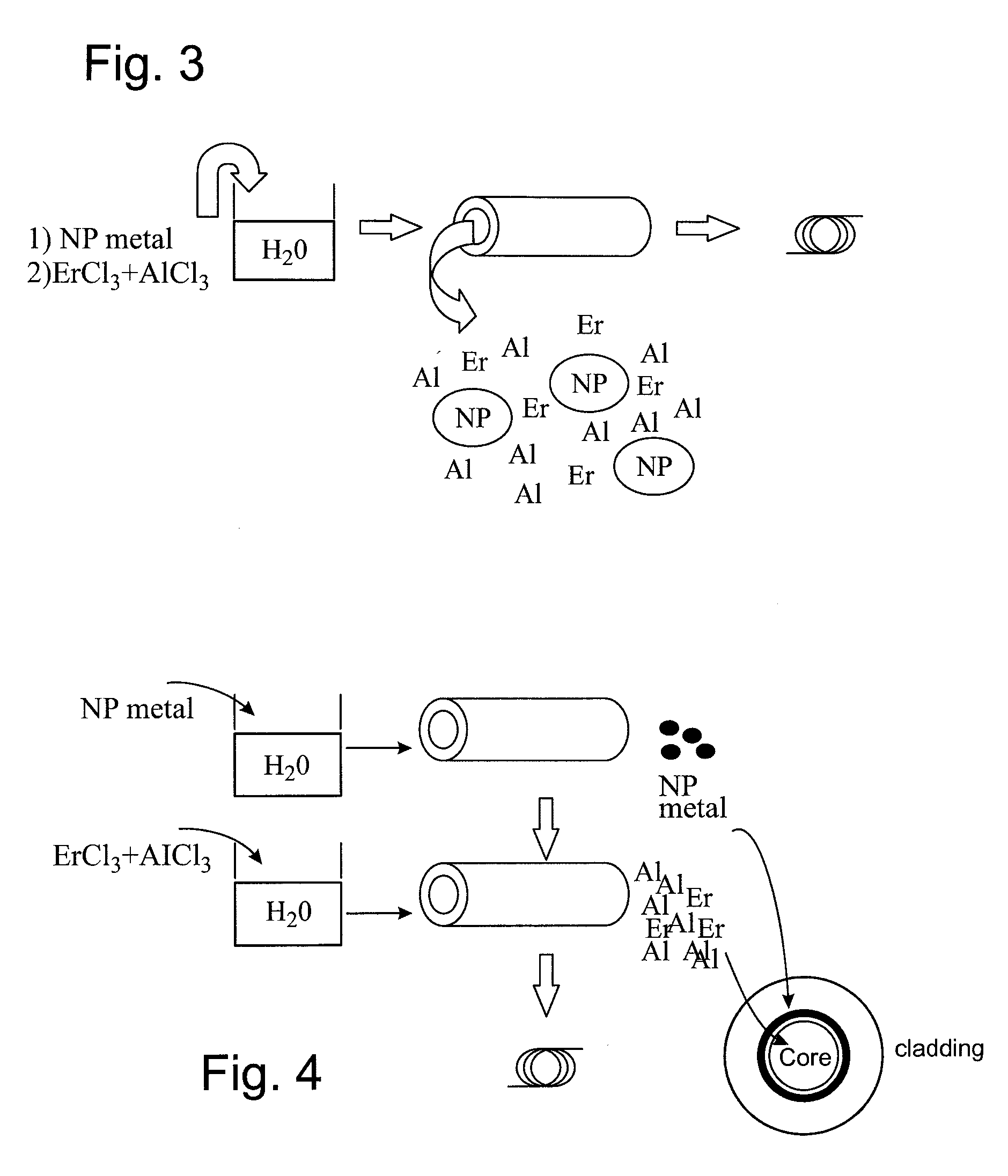Amplifier optical fiber comprising nanoparticles and production method
a nanoparticle and optical fiber technology, applied in the field of optical fibers, can solve the problems of complex and expensive stabilized laser sources that must be used, require the use of very powerful lasers which are expensive, and achieve the effect of improving signal amplification
- Summary
- Abstract
- Description
- Claims
- Application Information
AI Technical Summary
Benefits of technology
Problems solved by technology
Method used
Image
Examples
first embodiment
[0075]FIG. 3 illustrates an optical fiber according to the invention in which metallic nanostructures are incorporated into the Aluminium / Erbium co-doped core of a fiber. An erbium-doped aluminosilicate fiber comprising metallic nanostructures is then obtained. In this embodiment, the electron resonance wavelength will depend on the electron charge density, i.e. on the metal used, and on the diameter of the metallic nanostructures.
[0076]The metallic nanostructures nanoparticles can be produced by chemical or physical synthesis and dispersed in an aqueous solution. The erbium and aluminium dopants are then mixed with this solution by dissolution of their chlorinated precursors. The chlorinated precursors and the nanoparticles are then incorporated by the impregnation of a porous silica rod during an MCVD operation in order to obtain a preform from which an optical fiber can be formed.
second embodiment
[0077]In a second embodiment, illustrated in FIG. 4, the metallic nanostructures nanoparticles can be introduced into the vicinity of the erbium-doped core, at the core-cladding interface, in the form of a ring doped with metallic nanostructures. This embodiment makes it possible to further limit the losses by absorption while ensuring a sufficient proximity between the erbium atoms and the metallic nanostructures in order to guarantee the energy transfer by SPR effect. The metallic nanostructures nanoparticles produced by chemical or physical synthesis are dispersed in an aqueous solution; and the erbium and aluminium dopants are dissolved in a separate solution. The doping elements (Al, Er) then the metallic nanostructures (NP) are then incorporated by impregnation of a porous silica rod during an MCVD operation in order to obtain a preform from which an optical fiber can be formed.
third embodiment
[0078]FIG. 5 illustrates an optical fiber according to the invention in which nanostructures formed from an assembly of aluminium and erbium atoms are coated with a metallic layer. A fiber comprising Al / Er nanoparticles surrounded by a metallic coating is then obtained. In this embodiment, the electron resonance wavelength will depend on the electron charge density, i.e. on the metal used, the thickness of the metallic layer and the external diameter of the nanostructures. For example, in the publication of J. Aizpurua et al., Phys Rev Lett. vol 90 No. 5, 2003, cited above, it has been demonstrated for rings of gold with an external diameter of 60 nm that the resonance wavelength shifts from 700 nm towards 1400 nm when the thickness of the ring passes from 14 nm to 9 nm. Al / Er nanoparticles can be produced by chemical or physical synthesis leading to a powder of nanoscopic grains. The powder is then coated with a metallic layer by chemical or physical synthesis. The metal coating ca...
PUM
| Property | Measurement | Unit |
|---|---|---|
| diameter | aaaaa | aaaaa |
| diameter | aaaaa | aaaaa |
| melting point | aaaaa | aaaaa |
Abstract
Description
Claims
Application Information
 Login to View More
Login to View More - R&D
- Intellectual Property
- Life Sciences
- Materials
- Tech Scout
- Unparalleled Data Quality
- Higher Quality Content
- 60% Fewer Hallucinations
Browse by: Latest US Patents, China's latest patents, Technical Efficacy Thesaurus, Application Domain, Technology Topic, Popular Technical Reports.
© 2025 PatSnap. All rights reserved.Legal|Privacy policy|Modern Slavery Act Transparency Statement|Sitemap|About US| Contact US: help@patsnap.com



